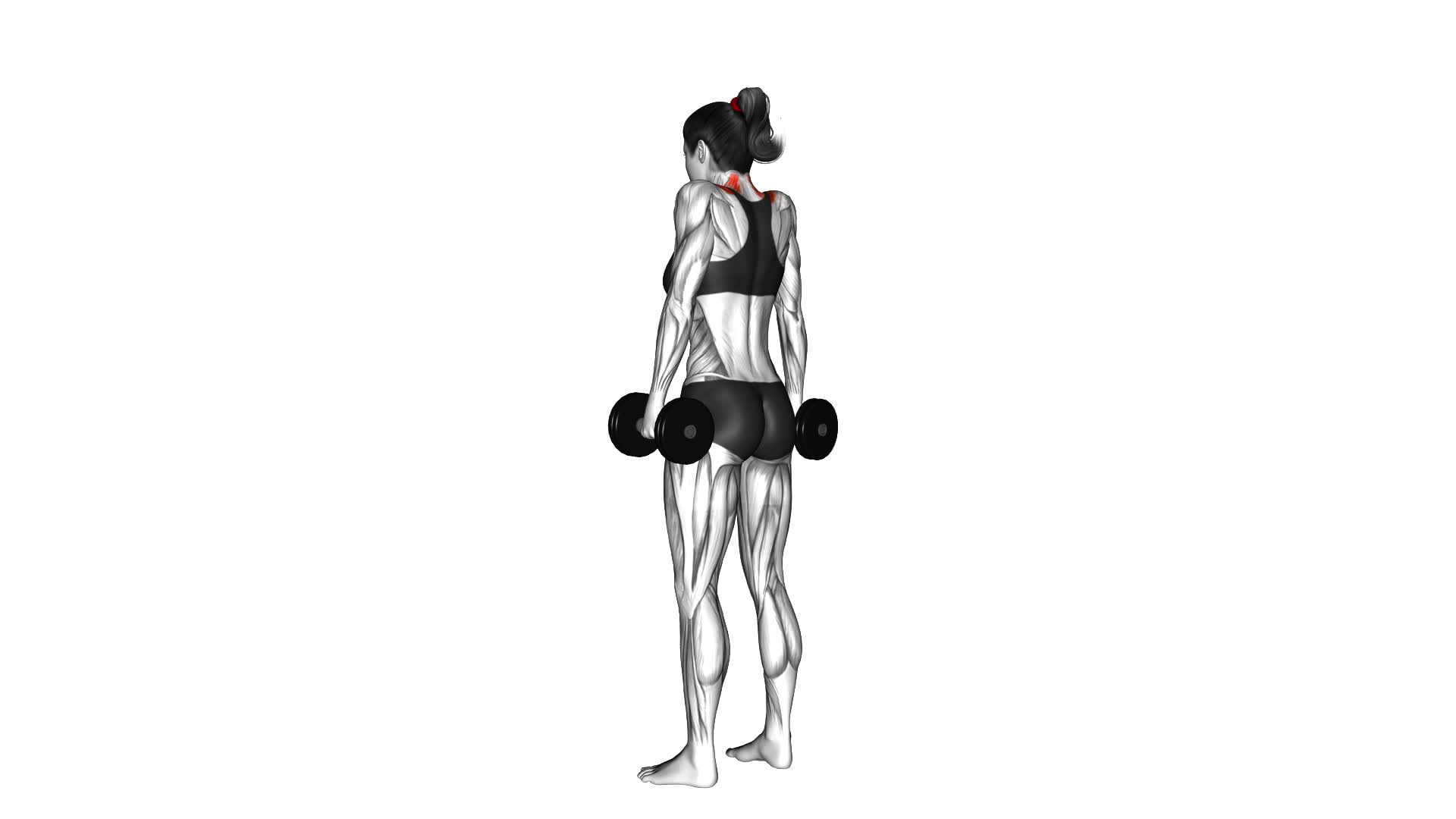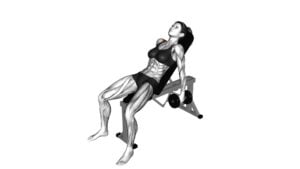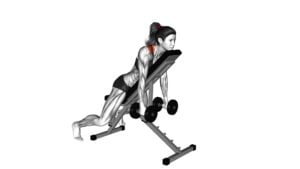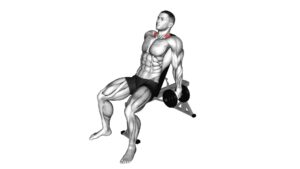Dumbbell Shrug (female) – Video Exercise Guide & Tips

Are you looking for an effective way to strengthen and tone your upper back and shoulders? Look no further than the dumbbell shrug!
Watch This Exercise Video
In this video exercise guide, we'll show you the proper form for performing dumbbell shrugs specifically tailored for females.
You'll also learn how to choose the right dumbbell weight, variations and modifications to try, and common mistakes to avoid.
Get ready to maximize your workout and achieve your fitness goals with the dumbbell shrug!
Key Takeaways
- Dumbbell shrugs for females can strengthen the upper body, particularly the trapezius muscles.
- Proper form is crucial to maximize gains, avoid injuries, and target the right muscles.
- Choosing the right dumbbell weight is important to challenge the muscles without compromising form.
- Engaging the core, maintaining a neutral spine, and avoiding the use of arms to lift the dumbbells are essential for proper form.
Benefits of Dumbbell Shrugs for Females
You can reap numerous benefits from incorporating dumbbell shrugs into your workout routine as a female. Dumbbell shrugs are a great exercise for building upper body strength, especially targeting the trapezius muscles.
By performing dumbbell shrugs, you can strengthen your shoulders, upper back, and neck muscles, which can help improve your posture and overall upper body stability.
Incorporating dumbbell shrugs into a full body workout routine can provide you with a well-rounded fitness regimen. Since dumbbell shrugs primarily focus on the upper body, they serve as a valuable addition to any upper body strength training program. They can be easily incorporated into your existing routine, making them a convenient choice for women looking to improve their overall strength and fitness levels.
Furthermore, dumbbell shrugs can also help enhance your grip strength, as you need to hold onto the dumbbells tightly throughout the exercise. This can be beneficial for women who participate in activities that require a strong grip, such as weightlifting or rock climbing.
To maximize the benefits of dumbbell shrugs, it's important to perform them with proper form and technique. Start by standing with your feet hip-width apart, holding a dumbbell in each hand with a neutral grip. Lift your shoulders up towards your ears as high as possible, hold for a brief moment, and then slowly lower them back down. Remember to keep your back straight and avoid using your arms to lift the dumbbells.
Proper Form for Dumbbell Shrugs
To perform dumbbell shrugs with proper form, start by standing up straight with your feet shoulder-width apart. Hold a dumbbell in each hand, with your arms fully extended and palms facing your body.
Lift your shoulders up towards your ears, squeezing your traps at the top of the movement. Keep your core engaged and maintain a neutral spine throughout the exercise.
Proper form ensures that you target the targeted muscles effectively and reduces the risk of injury.
Shoulder Positioning for Shrugs
For optimal form during dumbbell shrugs, focus on maintaining proper shoulder positioning throughout the exercise. Proper shoulder alignment is crucial to avoid shoulder strain and maximize the benefits of this exercise.
Start by standing tall with your feet shoulder-width apart, and hold a dumbbell in each hand with an overhand grip. Keep your shoulders relaxed and down, away from your ears.
As you lift the dumbbells, ensure that your shoulders remain in a neutral position, neither hunched forward nor pulled back excessively. Avoid shrugging or rolling your shoulders during the movement.
By maintaining proper shoulder positioning, you engage the targeted muscles effectively and minimize the risk of injury.
Now let's explore the benefits of proper form in dumbbell shrugs.
Benefits of Proper Form
What are the benefits of maintaining proper form in dumbbell shrugs?
Proper form is crucial when performing dumbbell shrugs as it not only maximizes gains but also helps in avoiding injuries.
When you maintain proper form, you ensure that you're targeting the right muscles, which leads to better muscle activation and growth.
By keeping your shoulders down and back, you engage the trapezius muscles effectively, allowing you to lift heavier weights and build more strength.
Additionally, maintaining proper form helps to avoid excessive strain on the neck and back, reducing the risk of injury.
It also ensures that you're using the correct range of motion, optimizing the exercise's effectiveness.
Choosing the Right Dumbbell Weight
You should select an appropriate dumbbell weight based on your individual strength and fitness level. Choosing the right weight is crucial for performing the dumbbell shrug exercise effectively and safely. It's important to find a weight that challenges your muscles without compromising your form. If the weight is too light, you won't be able to fully engage your muscles and achieve optimal results. On the other hand, if the weight is too heavy, you may strain your muscles or put yourself at risk of injury.
To determine the appropriate dumbbell weight, start with a weight that you think you can comfortably lift for 10 to 12 repetitions with proper form. If you can easily complete the set without feeling any fatigue in your muscles, the weight is too light. Gradually increase the weight until you find a challenging but manageable load. Remember, it's better to start with a lighter weight and progressively increase as you gain strength, rather than starting too heavy and risking injury.
Proper technique is essential when performing the dumbbell shrug exercise. Focus on maintaining a neutral spine, keeping your shoulders down and back, and avoiding any jerking or swinging motions. By selecting the right dumbbell weight, you can ensure that you perform the exercise with proper form, allowing your muscles to work efficiently and effectively.
Now that you understand the importance of choosing the right dumbbell weight, let's explore some variations and modifications for dumbbell shrugs.
Variations and Modifications for Dumbbell Shrugs
Try incorporating different grip positions to add variety and target different muscles during your dumbbell shrugs. Here are three variations and modifications you can try:
- Wide Grip Shrugs: Instead of holding the dumbbells with a shoulder-width grip, try holding them with a wider grip. This variation targets the outer traps and upper back muscles more effectively. Make sure to maintain proper form and avoid overextending your shoulders.
- Reverse Grip Shrugs: Instead of the traditional overhand grip, try using an underhand grip. This modification shifts the emphasis to the lower traps and rhomboids, giving you a unique stimulus for muscle growth. Keep your wrists relaxed and focus on squeezing your shoulder blades together at the top of the movement.
- Single Arm Shrugs: To further challenge your muscles and improve stability, try performing dumbbell shrugs one arm at a time. This variation allows you to focus on each side individually, ensuring balanced development. Keep your core engaged and maintain a neutral spine throughout the exercise.
Common Mistakes to Avoid During Dumbbell Shrugs
When performing dumbbell shrugs, it's important to avoid common mistakes that can hinder your progress.
One common mistake is incorrect shoulder positioning, where you fail to properly retract and depress your shoulder blades. This can lead to ineffective shrugs and potential shoulder injuries.
Another mistake to avoid is neglecting proper form, such as using momentum or shrugging too high, which can take the focus away from your traps.
Lastly, overloading with heavy weights can compromise your form and increase the risk of injury, so it's crucial to choose a weight that allows you to maintain proper technique throughout the exercise.
Incorrect Shoulder Positioning
Ensure proper shoulder positioning during dumbbell shrugs to maximize effectiveness and prevent injury. Incorrect shoulder positioning can lead to limited shoulder mobility and potential strain or injury.
Here are three common misconceptions to avoid when it comes to shoulder positioning during dumbbell shrugs:
- Avoid rounding your shoulders forward: Keep your shoulders back and down throughout the exercise to maintain proper alignment and engage the target muscles effectively.
- Don't shrug too high: Avoid lifting your shoulders excessively towards your ears. Instead, focus on squeezing your shoulder blades together while keeping your neck relaxed.
- Avoid excessive leaning or arching: Maintain a neutral spine and avoid leaning forward or arching your back during the exercise. This helps to protect your spine and maintain proper form.
Neglecting Proper Form
To avoid neglecting proper form during dumbbell shrugs, focus on maintaining correct shoulder positioning and avoiding common mistakes.
One common mistake is using too much weight, which can lead to improper form and potential injury. It's important to start with a weight that allows you to perform the exercise with control and proper technique.
Another mistake to avoid is shrugging the shoulders upward instead of pulling them back and squeezing the shoulder blades together. This can reduce the effectiveness of the exercise and put unnecessary strain on the neck and upper back.
To maximize results, engage the core muscles and keep the spine straight throughout the movement. Remember to breathe consistently and avoid rushing through the exercise.
Overloading With Heavy Weights
To avoid overloading with heavy weights during dumbbell shrugs, focus on maintaining proper form and avoiding potential injuries by using a weight that allows you to perform the exercise with control and proper technique. Overloading techniques can be tempting, but it's important to prioritize injury prevention.
Here are three key tips to keep in mind:
- Start with a manageable weight: Choose a weight that challenges you but still allows you to maintain good form throughout the exercise. Gradually increase the weight as you get stronger and more comfortable with the movement.
- Use a controlled range of motion: Avoid jerking or bouncing the weights at the top of the movement. Instead, focus on a slow and controlled lifting motion to fully engage the muscles and reduce the risk of injury.
- Listen to your body: Pay attention to any discomfort or pain during the exercise. If something doesn't feel right, lower the weight or adjust your technique to prevent injury.
Tips for Maximizing Your Dumbbell Shrug Workout
Get the most out of your dumbbell shrug workout by incorporating these tips and techniques. If you want to maximize the results of your dumbbell shrugs, it's important to incorporate them into a full body workout routine. By doing so, you'll be able to target multiple muscle groups and increase overall strength and muscle definition.
When incorporating dumbbell shrugs into a full body workout, it's important to start with a proper warm-up. This will help prepare your muscles for the exercises to come and reduce the risk of injury. Begin with some light cardio, such as jogging or jumping jacks, followed by dynamic stretches to loosen up your shoulders and upper back.
During your dumbbell shrug workout, focus on maintaining proper form. Stand tall with your feet shoulder-width apart and hold a dumbbell in each hand at your sides. Keep your shoulders relaxed and your core engaged. As you lift the dumbbells, focus on squeezing your shoulder blades together and lifting with your traps. Avoid using momentum or swinging the weights, as this can lead to improper form and reduce the effectiveness of the exercise.
To maximize the results of your dumbbell shrug workout, gradually increase the weight you're lifting. This will challenge your muscles and promote growth and strength gains. Start with a weight that allows you to perform 10-12 reps with proper form, and gradually increase the weight as you become stronger.
Incorporating dumbbell shrugs into a full body workout routine can help you achieve your fitness goals faster and more effectively. Remember to listen to your body, rest when needed, and stay consistent with your workouts. With these tips and techniques, you'll be well on your way to maximizing your dumbbell shrug workout.
Frequently Asked Questions
How Many Sets and Repetitions Should I Do When Performing Dumbbell Shrugs?
When performing dumbbell shrugs, it's important to focus on sets and repetitions that suit your fitness level and goals. Start with 3 sets of 10-12 reps and adjust accordingly.
Dumbbell shrugs are a great way to strengthen your upper body, especially your traps and shoulders. By incorporating different variations of the exercise, you can target different muscle groups and enhance overall strength.
Remember to maintain proper form and gradually increase weight for maximum benefits.
Can Dumbbell Shrugs Help With Improving Posture?
Dumbbell shrugs can be beneficial for improving posture. By targeting the muscles in your upper back and shoulders, this exercise can help strengthen and stabilize the muscles that support proper alignment.
Regularly incorporating dumbbell shrugs into your workout routine can help alleviate muscle imbalances and promote a more upright posture. Additionally, the increased strength in these muscles can also enhance overall upper body strength and functionality.
Is It Necessary to Use a Weightlifting Belt When Performing Dumbbell Shrugs?
When performing dumbbell shrugs, you may wonder if it's necessary to use a weightlifting belt. While a weightlifting belt can provide support and stability, it isn't essential for this exercise.
The primary purpose of a weightlifting belt is to protect the lower back during heavy lifts. If you're not lifting extremely heavy weights, you can opt for alternatives such as focusing on maintaining proper form and engaging your core muscles to support your back.
Can Dumbbell Shrugs Be Performed Using Other Equipment, Such as a Barbell or Kettlebell?
Dumbbell shrugs can be performed using other equipment, such as a barbell or kettlebell. However, it's important to note that using a resistance band for dumbbell shrugs can also be effective for targeting the trapezius muscles.
When comparing dumbbell shrugs to barbell shrugs, it's worth mentioning that both exercises work the same muscle group, but the barbell allows for heavier weights to be used.
Ultimately, the choice of equipment depends on your personal preference and fitness goals.
Are There Any Specific Breathing Techniques That Should Be Followed During Dumbbell Shrugs?
When performing dumbbell shrugs, it's important to pay attention to your breathing patterns. Proper breathing can have several benefits during this exercise.
It helps stabilize your core and maintain proper form. Inhale deeply before starting the movement, and exhale as you lift the dumbbells up, engaging your shoulder muscles. Remember to breathe out slowly and controlled.
This technique will help you maximize the effectiveness of the exercise and prevent any unnecessary strain.
Conclusion
In conclusion, dumbbell shrugs are a highly effective exercise for females, providing numerous benefits such as strengthening the upper back and improving posture.
To perform the exercise correctly, it's important to maintain proper form and choose the appropriate dumbbell weight.
There are also variations and modifications available to cater to individual fitness levels.
Avoiding common mistakes and following helpful tips will help maximize the effectiveness of your dumbbell shrug workout.
Incorporate this exercise into your routine for a stronger and more toned upper body.

Author
Years ago, the spark of my life’s passion ignited in my mind the moment I stepped into the local gym for the first time. The inaugural bead of perspiration, the initial endeavor, the very first surge of endorphins, and a sense of pride that washed over me post-workout marked the beginning of my deep-seated interest in strength sports, fitness, and sports nutrition. This very curiosity blossomed rapidly into a profound fascination, propelling me to earn a Master’s degree in Physical Education from the Academy of Physical Education in Krakow, followed by a Sports Manager diploma from the Jagiellonian University. My journey of growth led me to gain more specialized qualifications, such as being a certified personal trainer with a focus on sports dietetics, a lifeguard, and an instructor for wellness and corrective gymnastics. Theoretical knowledge paired seamlessly with practical experience, reinforcing my belief that the transformation of individuals under my guidance was also a reflection of my personal growth. This belief holds true even today. Each day, I strive to push the boundaries and explore new realms. These realms gently elevate me to greater heights. The unique combination of passion for my field and the continuous quest for growth fuels my drive to break new ground.



